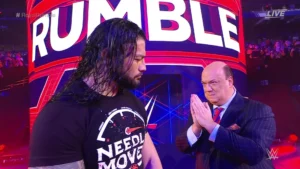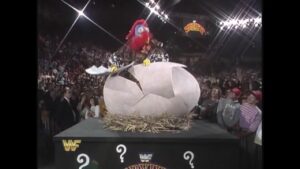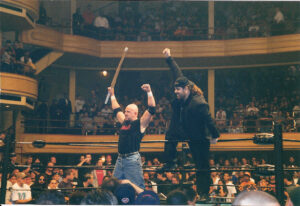If you think WWE working with Saudi Arabia has been pro wrestling’s shadiest dealings with a suspect government, think again. Next week marks the 25th anniversary of Collision in Korea, a joint production from World Championship Wrestling (WCW) and New Japan Pro Wrestling (NJPW) held beyond the Military Demarcation Line (MDL) separating North and South Korea at the May Day Stadium in Pyongyang, North Korea. Collision in Korea was held over two nights, April 28 to 29, 1995, with a “best of” aired by WCW on Pay-Per-View, which aired on August 4, 1995.

In 1995, NJPW wasn’t the global force it was today. But it was still one of Japan’s top promotions and held a huge presence in the Asian markets. NJPW founder Antonio Inoki had gotten into politics in 1989 and was looking to broaden his political spectrum. An international peace event would be just the thing to put his face back on the map. “Sometime in early ’95, Antonio called and asked me for help in trying to get Muhammad Ali to come over to this event that he described as a world peace event,” Eric Bischoff told Sports Illustrated back in 2015. “I thought, well, the little that I know about Muhammad and the kind of things he was interested in—it sounds unique. I said, ‘Where is it?’ I assumed it was in Tokyo. Then he said it was in Pyongyang, North Korea. Oh, wow. That’s really out there. Then he asked me about bringing some of the wrestlers that worked for me and Turner Broadcasting over as a part of this big show and asked if I would be there as a guest. I thought, Wow, what a phenomenal opportunity.”

WCW and NJPW would partner in alliance for much of the 1990s, putting on SuperShows on both continents and sharing talent on each other’s programming. WCW even created a secondary world title, the WCW International World Heavyweight championship that was mostly contested in Japan – although it would be retired in early 1994 when it was unified with the WCW World Heavyweight title following WCW’s departure from the National Wrestling Alliance (NWA) several months previously. The opening match of WCW Monday Nitro several months after Collision in Korea would feature WCW’s Brian Pillman versus NJPW legend Jushin ‘Thunder’ Liger, showcasing that alliance early. With New Japan bringing in their Western counterparts in WCW into Collision in Korea, it helped cement the event as a truly international experience.
For the most part, the bulk of the card would be staffed by New Japan wrestlers – even most of the WCW talents were ones who were simultaneously working in Japan with NJPW. But Antonio Inoki knew who he wanted as his main event opponent – he wanted his former New Japan ally Hulk Hogan. But while Hogan’s star had faded in North America, internationally he was still a huge part of pop culture – and Inoki wanted Hogan for the show’s main event. But Bischoff knew better. He told SI that he “might as well have asked (Hogan) to row a boat to Pluto” and Hulk Hogan turned down the offer. Which lead to Inoki’s eventual opponent, “Nature Boy” Ric Flair.

At the time, WCW was without a World champion…sort of. A week prior to Collision in Korea, at WCW Spring Stampede, a WCW World title match between champion Ric Flair and his longtime rival Ricky Steamboat, ended in a double pin. WCW held up the title for a future rematch which, although taped on April 21 – days before Korea – didn’t air until May on television. So for storyline purposes, Flair walked in Pyongyang, North Korea without any gold around his waist. But he was still arguably WCW’s top star. “I talked to some friends of mine in politics and asked what they thought, and they all thought I was crazy for going,” Flair recalled in an interview with USA Today in 204. “Back then I was just a team player, and they wanted me to go. I think they asked, if I’m not mistaken, George Foreman if he wanted to go. When I’m in the same light, the same consideration as George Foreman… that’s pretty cool and I’ll accept the opportunity.”
Ric Flair traveled to North Korea, joined in the WCW contingent with Scott Norton, The Steiner Brothers (Scott & Rick Steiner), 2 Cold Scorpio, and Road Warrior Hawk. At the time, the Steiners and Scott Norton was former 2x IWGP Tag Team Champions, while Hawk had a secondary career in New Japan as part of The Hellraisers with Power Warrior (Kensuke Sasaki) – the Hellraisers were also the reigning IWGP Tag Team Champions at the time. 2 Cold Scorpio was also well known to the New Japan crowds, having competed in the three previous Top of the Juniors (1991, 1992, 1993), the tournament rebranded the Best of the Super Juniors that following month.
The politics of North Korea where very much like those today, only instead of the dictator Kim Jong-un it was his father, the dictator Kim Jong-il. WCW was about to become the first Western wrestling company to attend North Korea in a country that was notoriously paranoid about Westerners entering their country. And while the lead up turned into a real cloak and dagger experience for the American wrestlers, the show turned into a huge success – it lead to the two single biggest attendance records for a pro wrestling event, with a reported 165,000 people in attendance on night one, and 190,000 people for the second. Although it appears there may have been some persuasion to get those numbers. “Me and Flair were taking the little crappy limo to the event the first day,” Scott Norton told Sports Illustrated. “I said, ‘Ric, man, we’re really drawing. Look at this.’ The driver looks back and says, ‘Excuse me, what do you mean by draw?’ I says, ‘That’s a term we use for when a lot of people are coming to see us.’ He says, ‘No, nobody really wants to come. It’s forced attendance. If they don’t show up they get a bullet in the head.’ And I went, ‘…all right then.’”
Two nights of pro wrestling went on, featuring NJPW talents mixed with WCW, plus showcases from All Japan Women’s Pro Wrestling (AJW). NJPW’s Hidekazu Tanaka was the official ring announcer for the two nights, with Masao Tayama and Tiger Hattori working as the official referees. On broadcast duties was WCW’s Eric Bischoff, Mike Tenay, and manager Sonny Onoo. The footage from Collision in Korea remains off both the WWE Network and NJPW World.
Collision in Korea – Night 1 Card
(* indicates match was shown on WCW Pay Per View on August 4, 1995)
- *Yuji Nagata vs. Tokimitsu Ishizawa
- *Akira Hokuto & Bull Nakano vs. Manami Toyota & Mariko Yoshida
- Hiroshi Hase vs. Wild Pegasus (Chris Benoit)
- *Ookami Gundan (Hiro Saito & Masahiro Chono) vs. El Samurai & Tadao Yasuda
- 2 Cold Scorpio vs. Shinjiro Otani
- Kensuke Sasaki vs.Masa Saito
- *IWGP Heavyweight Championship Match: Shinya Hashimoto (c) vs. Scott Norton
Collision in Korea – Night 2 Card
(* indicates match was shown on WCW Pay Per View on August 4, 1995)
- Hiro Saito vs. Yuji Nagata
- Akira Hokuto vs. Bull Nakano
- Black Cat vs. El Samurai
- *Wild Pegasus (Chris Benoit) vs. 2 Cold Scorpio
- Masahiro Chono & Scott Norton vs. Akira Nogami & Takayuki Iizuka
- *Road Warrior Hawk vs. Tadao Yasuda
- *The Steiner Brothers (Rick Steiner & Scott Steiner) vs. Hiroshi Hase & Kensuke Sasaki
- *Antonio Inoki vs. “Nature Boy” Ric Flair
Professional wrestling has never returned to North Korea since then, at least nowhere near the level of Collision in Korea – which is surprising, considering that former nWo member Dennis Rodman is one of the closest friends of Kim Jong-un. Perhaps one day.







